Research Progress on Stress–Fracture–Seepage Characteristics for Hazard Prevention in Mine Goafs: A Review
Abstract
:1. Introduction
2. Research Progress Analysis
2.1. Stress-Distribution Characteristics of Goaf Area
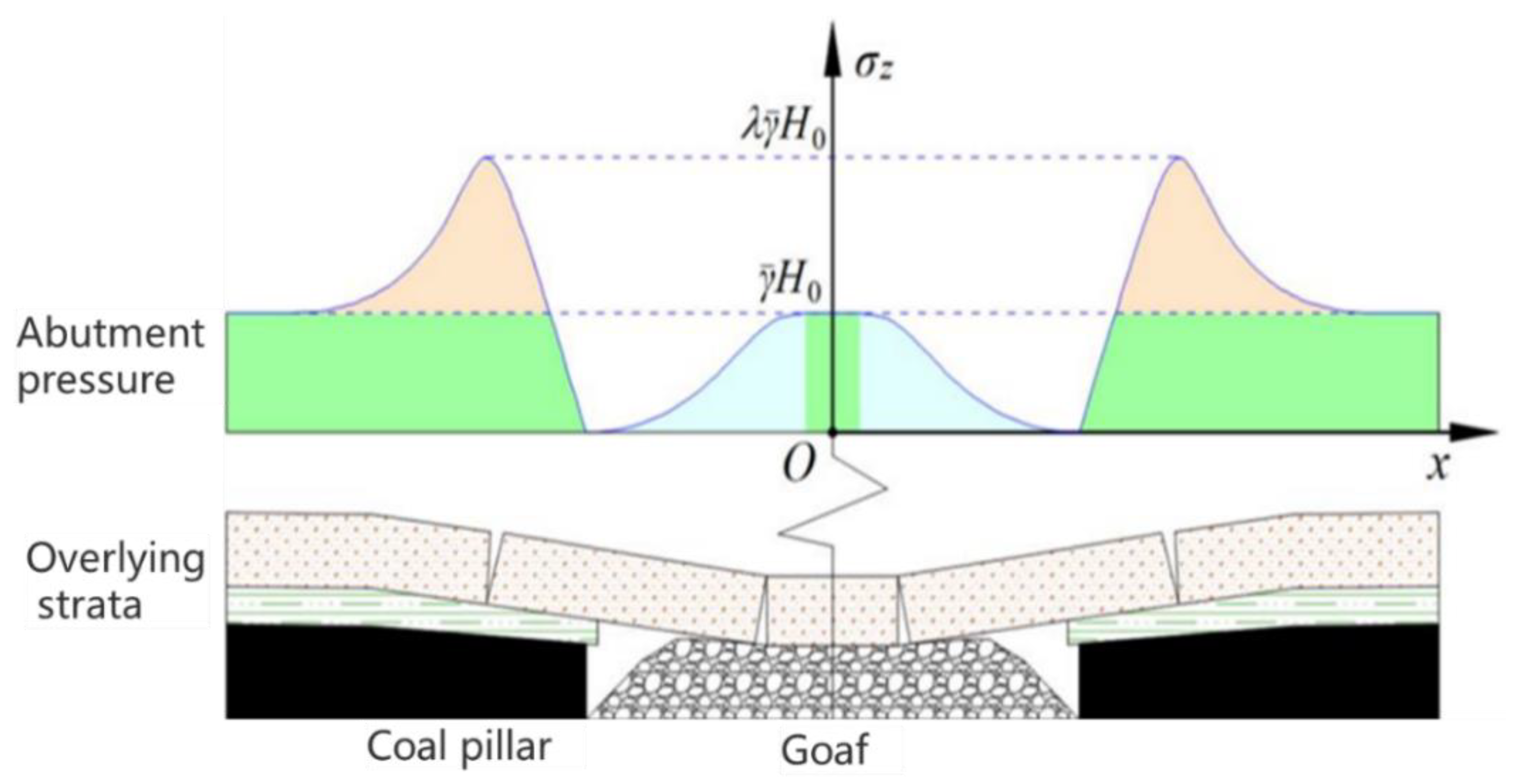
2.2. Development Law of Fractures in Mining Stopes
2.3. Distribution Characteristics of Permeability in Mining Stopes
3. Summary and Discussions
- (1)
- Stress variation: The weight of the overlying strata is evenly distributed over the coal seam before it is mined. With the advancement of longwall mining, a stress-relief zone is formed above the goaf area, while a stress-concentration zone is generated in the adjacent coal seams. The larger loading stress of the goaf area corresponds to the smaller loading stress of the surrounding rocks, and vice versa. After mining, the stress in the roof of the roadway goes through the process of stress relief, stress increase, and re-decompression [41]. The roof cutting of the roadway in the middle coal seam creates a stress-increase zone in the overlying strata between the upper and middle roadways. In addition, the roof cutting of the roadway in the lower coal seam causes serious damage to the surrounding rocks, leading to no concentrated stress;
- (2)
- Fracture development: For the multilayer-coal-seam group, the development pattern of the fractures in the overlying strata during upper-coal-seam (first-mined seam) mining is the same as for single-coal-seam mining. However, if the lower coal seam is subsequently mined, the superimposed mining destroys the equilibrium caused by the upper-coal-seam mining, resulting in a large development of fractures. The fractures in the overlying strata and floor strata of the mining area experience the process of stress-relief expansion, stress-recovery closure, and end-fracture expansion. The fracture closure in the middle of the mining area is accompanied by fracture expansion at the ends. Meanwhile, the fracture closure in the roof strata is faster than that in the floor strata;
- (3)
- Permeability changes: Affected by mining activities and external loads, microfractures inside coal and rock occurs, expands, and connects, which could result in an exponential increase in the permeability. The fracture ratio in the overlying strata has an obvious influence on the seepage characteristics. Whether it is vertical seepage or horizontal seepage, the permeability coefficient in the fractured zone of the goaf area increases with the growth in the fracture ratio, showing a power-curve relationship.
- (1)
- Due to the different research focuses and methods on the abutment pressure of longwall-mining faces, some differences exist in the research results. Therefore, further investigations are needed to characterize the distribution of the abutment pressure;
- (2)
- The two-dimensional mechanical model that describes the mining process should be extended to three-dimensional ones to more accurately reveal the mechanism of the fracture development in overlying strata. Meanwhile, more tests are needed to simulate the actual rock-fracturing processes, and the physical-model tests that reflect the effects of the shear stress or three-dimensional stress need to be enhanced;
- (3)
- A large number of studies on the development pattern of fractures in overlying strata show that overlying fractures at the goaf boundary are difficult to self-close after mining. These fractures are the main seepage channels of water and gas, and they need to be comprehensively investigated. On the premise of fixed-fracture laminar flow, the physical-similarity simulation test plays a good role in studying the seepage characteristics of fractured rocks. Meanwhile, research on fracture-filled seepage is more practical and worth further investigation;
- (4)
- In the process of longwall mining, damage to the overlying strata at the mining-stope boundary is serious [46]. The fractures are highly developed, and compaction and closure are difficult [41]. The permeability of the damaged coal could increase by hundreds or thousands of times. In previous studies, few permeability models have considered the effects of the damage. Thus, the accuracy of coupled gas-seepage studies at the goaf boundary is expected to be improved. It is necessary to establish a multifactor coupled permeability model that integrates the coal damage, stress, and gas desorption. Through this model, changes in the permeability at the goaf boundary and the dynamic evolution of the multifield gas coupling seepage characteristics could be accurately analyzed, and the gas-rich areas could be identified. As a result, the gas-extraction performance at the goaf boundary could be enhanced. The amount of gas emissions from the goaf-boundary area and from the roof and floor rock strata to the goaf would be reduced, ensuring safe and efficient mining.
Author Contributions
Funding
Institutional Review Board Statement
Informed Consent Statement
Data Availability Statement
Conflicts of Interest
References
- Xie, H.; Wang, J.; Wang, G.; Ren, H.; Liu, J.; Ge, S.; Zhou, H.; Wu, G.; Ren, S. New ideas of coal revolution and layout of coal science and technology development. J. China Coal Soc. 2018, 43, 1187–1197. [Google Scholar]
- Lin, B.; Wei, W.; Li, P. China’s long -run coal demand:Lmpacts and policy choice. Econ. Res. 2007, 2, 48–58. [Google Scholar]
- Yang, F. Analysis of the demand prospect of coal products in China’s power industry. China Coal 2020, 46, 22–31. [Google Scholar]
- Jiang, D.; Cheng, H. Medium and long term forecast and prospect of coal consumption in China. Coal Econ. Res. 2020, 40, 16–21. [Google Scholar]
- Li, W.; Wang, Q.; Li, X. Reconstruction of aquifuge: The engineering geological study of n2 laterite located in key aquifuge concerning coal mining with water protection in northwest China. J. China Coal Soc. 2017, 42, 88–97. [Google Scholar]
- Wang, H.; Jiang, Y.; Zhao, Y.; Jie, Z.; Shuai, L. Numerical investigation of the dynamic mechanical state of a coal pillar during longwall mining panel extraction. Rock Mech. Rock Eng. 2013, 46, 1211–1221. [Google Scholar] [CrossRef]
- Yavuz, H. An estimation method for cover pressure re-establishment distance and pressure distribution in the goaf of longwall coal mines. Int. J. Rock Mech. Min. Sci. 2004, 41, 193–205. [Google Scholar] [CrossRef]
- Zou, J.; Chen, W.; Yuan, J.; Yang, D.; Yang, J. 3-D numerical simulation of hydraulic fracturing in a cbm reservoir. J. Nat. Gas Sci. Eng. 2016, 37, 386–396. [Google Scholar] [CrossRef]
- Wang, S.; Huang, Q.; Fan, L.; Yang, Z.; Shen, T. Study on overburden aquclude and water protection mining regionazation in the ecological fragile mining area. J. China Coal Soc. 2010, 35, 7–14. [Google Scholar]
- JI, Y.; LI, H.; Song, G. Stress distribution of surrounding rock and movement law of overlying rock under different filling methods. Shaanxi Coal 2022, 41, 7–11. [Google Scholar]
- Qian, M.; Shi, P.; Xu, J. Ground Pressure and Strata Control; China University of Mining and Technology Press: Xuzhou, China, 2010. [Google Scholar]
- Yang, H.; Liu, Y.; Li, Y.; Pan, R.; Wang, H.; Cao, S. Study on strata stress and deformation response of contiguous seams under cutting roof for entry retaining. Min. Saf. Environ. Prot. 2022, 49, 8–13. [Google Scholar]
- Kang, H.; Lou, J.; Gao, F.; Yang, J.; Li, J. A physical and numerical investigation of sudden massive roof collapse during longwall coal retreat mining. Int. J. Coal Geol. 2018, 188, 25–36. [Google Scholar] [CrossRef]
- Di, S.; Zhang, S.; Cao, Y.; Xue, L. Study on failure form and stress evolution law of overlying strata in fully mechanized mining face. Shanxi Coking Coal Sci. Technol. 2020, 44, 41–45. [Google Scholar]
- Whittaker, B.; Singh, R. Evaluation of the design requirements and performance of gate roadways. Min. Eng. 1979, 138, 535–548. [Google Scholar]
- Zhu, S.; Feng, Y.; Jiang, F. Determination of abutment pressure in coal mines with extremely thick alluvium stratum: A typical kind of rockburst mines in China. Rock Mech. Rock Eng. 2016, 49, 1943–1952. [Google Scholar] [CrossRef]
- Yasitli, N.E.; Unver, B. 3d numerical modeling of longwall mining with top-coal caving. Int. J. Rock Mech. Min. Sci. 2005, 42, 219–235. [Google Scholar] [CrossRef]
- Rezaei, M.; Hossaini, M.F.; Majdi, A. Determination of longwall mining-induced stress using the strain energy method. Rock Mech. Rock Eng. 2015, 48, 2421–2433. [Google Scholar] [CrossRef]
- Yu, B.; Zhang, Z.; Kuang, T.; Liu, J. Stress changes and deformation monitoring of longwall coal pillars located in weak ground. Rock Mech. Rock Eng. 2016, 49, 3293–3305. [Google Scholar] [CrossRef]
- Xie, G.; Wang, L. Effect of mining thickness on abutment pressure of working face. J. China Coal Soc. 2008, 33, 361–363. [Google Scholar]
- Yu, Y. Deformation Characteristics and Permeability Evolution Laws of Strata on Stope Boundary; China University of Mining & Technology: Xuzhou, China, 2020. [Google Scholar]
- Zhang, J. Study on failure mode and stress evolution law of mining overburden in fully mechanized mining face. Shanxi Chem. Ind. 2021, 41, 107–110. [Google Scholar]
- Wang, W.; Wang, S.; Liu, H.; Jiang, T.; Ren, M. The space and time characteristics of the cover stress re-establishment of the fractured rock mass in the goaf after coal mining. J. Min. Saf. Eng. 2017, 34, 127–133. [Google Scholar]
- Gao, Z. Research on the Law of Overlying Rock Failure in the Goaf of Coal Mine; Chang’an University: Xi’an, China, 2021. [Google Scholar]
- LI, J.-h.; Wang, S.; He, Y.-j.; Wang, L.; Zhao, M. Fissure evolution of gob overlying strata under superimposed mining in coal seams group. Coal Eng. 2021, 53, 92–96. [Google Scholar]
- Zhang, J.; Zhang, J.; Liu, Q.; Zhou, F.; Chen, C. Crack development and air leakage law of overburden rock in shallow fully mechanized face. Coal Eng. 2021, 53, 118–123. [Google Scholar]
- Zhao, J.; Zhang, L.; Wang, S. Measurement and evolution law of overburden fracture angle in high cutting stope with composite roof. Coal Eng. 2021, 53, 75–78. [Google Scholar]
- Zhao, Y.; Liu, W.; Zhang, C.; Liu, H.; Wei, Y.; Wang, P.; Shi, Y.; Zhai, J.; Gao, S. Stress and fracture evolution of surrounding rock during mining above mined out area in contiguous coal seams. J. China Coal Soc. 2022, 47, 259–273. [Google Scholar]
- Zhang, J.; He, Y.; Wang, X.; Feng, C.; Yang, T.; Kang, X.; Li, H. Analysis and research on overburden failure laws under repeated mining in shallow-buried and close coal seam group. Min. R D 2022, 42, 60–64. [Google Scholar]
- Qian, M.; Xu, J. Study on the “o-shape” circle distribution characteristics of mining. J. China Coal Soc. 1998, 5, 20–23. [Google Scholar]
- Liu, H.; Zhao, Y.; Ren, T.; Wang, F.; Li, Z. Characteristics of overburden failure and fracture development in gob of mining with gob-side entry formed by cutting roof. J. China Univ. Min. Technol. 2022, 51, 77–89. [Google Scholar]
- Li, W. Research on failure mechanism of overlying rock strata in tunnel goaf based on pfc3d. Railw. Constr. Technol. 2022, 32, 38–43. [Google Scholar]
- Zhang, Y.; Xu, L.; Liu, K.; Li, Y.; Zhang, B.; Li, W. Formation mechanism and evolution laws of gas flow channel in mining coal and rock. J. China Coal Soc. 2012, 37, 1444–1450. [Google Scholar]
- Xiong, X.; Zhang, C.; Wang, E. A review of steady state seepage in a single fracture of rock. Chin. J. Rock Mech. Eng. 2009, 28, 1839–1847. [Google Scholar]
- Meng, Z.; Zhang, J.; Shi, X.; Tian, Y.; Li, C. Calculation model of rock mass permeability in coal mine goaf and its numerical simulation analysis. J. China Coal Soc. 2016, 41, 1997–2005. [Google Scholar]
- Wang, Y. Study on Fracture and Permeability Evolution Law of Overlying Rock at Stope Boundary; China University of Mining & Technology: Xuzhou, China, 2021. [Google Scholar]
- Zhang, D.; Qi, X.; Song, R.; Yin, G. Coupling mechanism of rock mass stress and gas flow in coal mining fissures. J. China Coal Soc. 2015, 40, 774–780. [Google Scholar]
- Xue, S.; Zheng, C.; Mehmet, K.; Jiang, B.; Wang, Z.; Tang, M.; Chen, Z. Coal Permeability Models for Enhancing Performance of Clean Gas Drainage: A Review. J. Pet. Sci. Eng. 2021, 199, 108283. [Google Scholar] [CrossRef]
- Cui, X.; Bustin, R.M. Volumetric strain associated with methane desorption and its impact on coalbed gas production from deep coal seams. AAPG Bull. 2005, 89, 1181–1202. [Google Scholar] [CrossRef]
- Gu, F.; Chalaturnyk, R. Permeability and porosity models considering anisotropy and discontinuity of coalbeds and application in coupled simulation. J. Petrol. Sci. Eng. 2010, 74, 113–131. [Google Scholar] [CrossRef]
- Zhou, X.; Wang, S.; Li, X. Research on theory and technology of floor heave control in semicoal rock roadway: Taking longhu coal mine in Qitaihe mining area as an Example. Lithosphere 2022, 11, 3810988. [Google Scholar] [CrossRef]
- Qian, D.; Zhang, N.; Shimada, H.; Wang, C.; Sasaoka, T.; Zhang, N. Stability of goaf-side entry driving in 800-m-deep island longwall coal face in underground coal mine. Arab. J. Geosci. 2016, 9, 82. [Google Scholar] [CrossRef]
- Yu, Y.-x.; Huang, R.-b.; Wang, B.-q. Analysis on limit equilibrium zone of coal pillar in mining roadway based on mechanical model of elastic foundation beam. J. Eng. Mech. 2016, 142. [Google Scholar] [CrossRef]
- Wang, P.; Feng, G.; Zhao, J.; Chugh, Y.; Wang, Z. Effect of longwall gob on distribution of mining-induced stress. Chin. J. Geotech. Eng. 2018, 40, 1237–1246. [Google Scholar]
- Zhang, W.; Zhou, C.; Li, J.; Li, X. Research progress of experimental study on seepage characteristic of fractured rock masses. Rock Soil Mech. 2005, 26, 1517–1524. [Google Scholar]
- Liu, H.; Zhang, B.; Li, X. Research on roof damage mechanism and control technology of gob-side entry retaining under close distance gob. Eng. Fail. Anal. 2022, 138, 106331. [Google Scholar] [CrossRef]
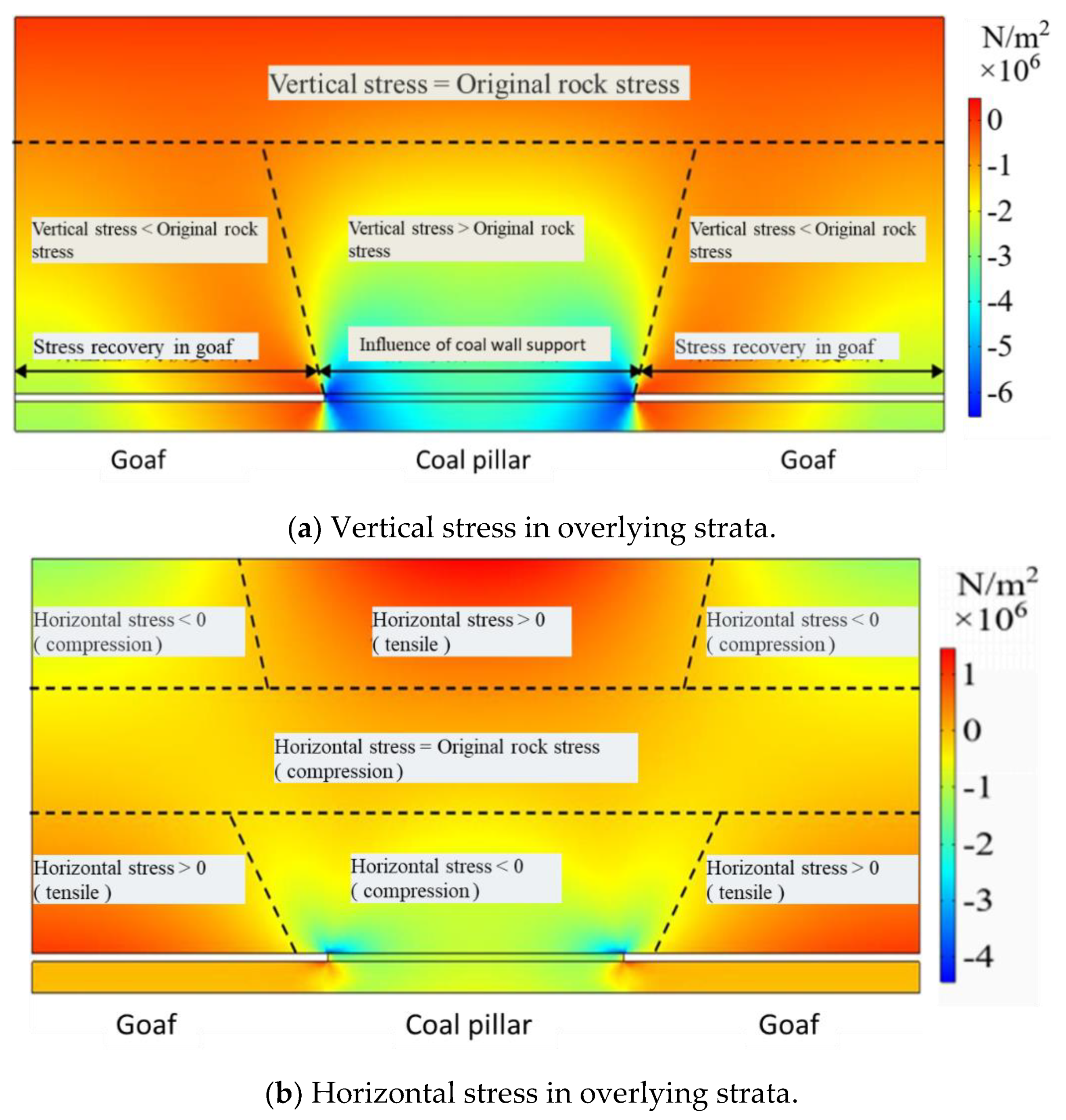
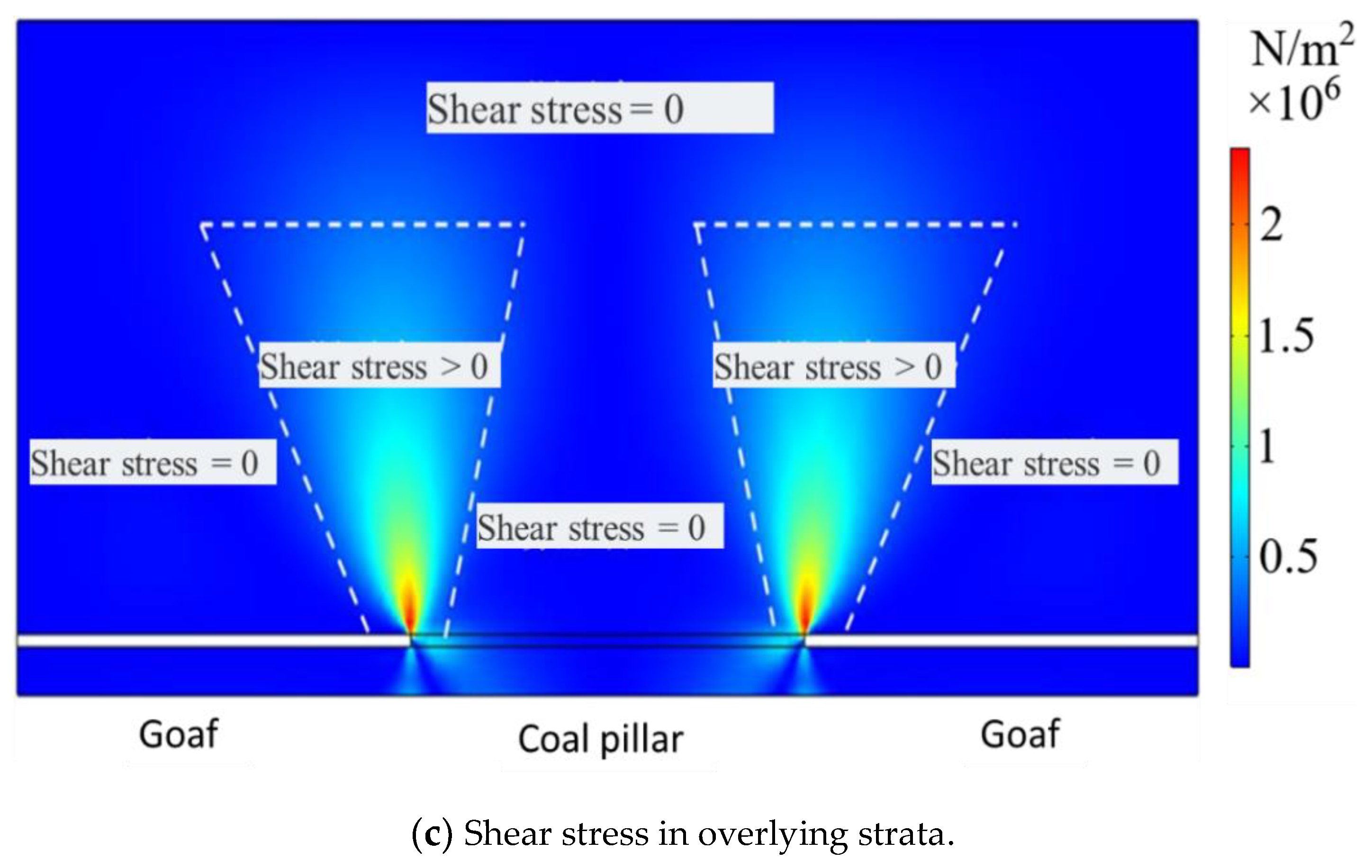
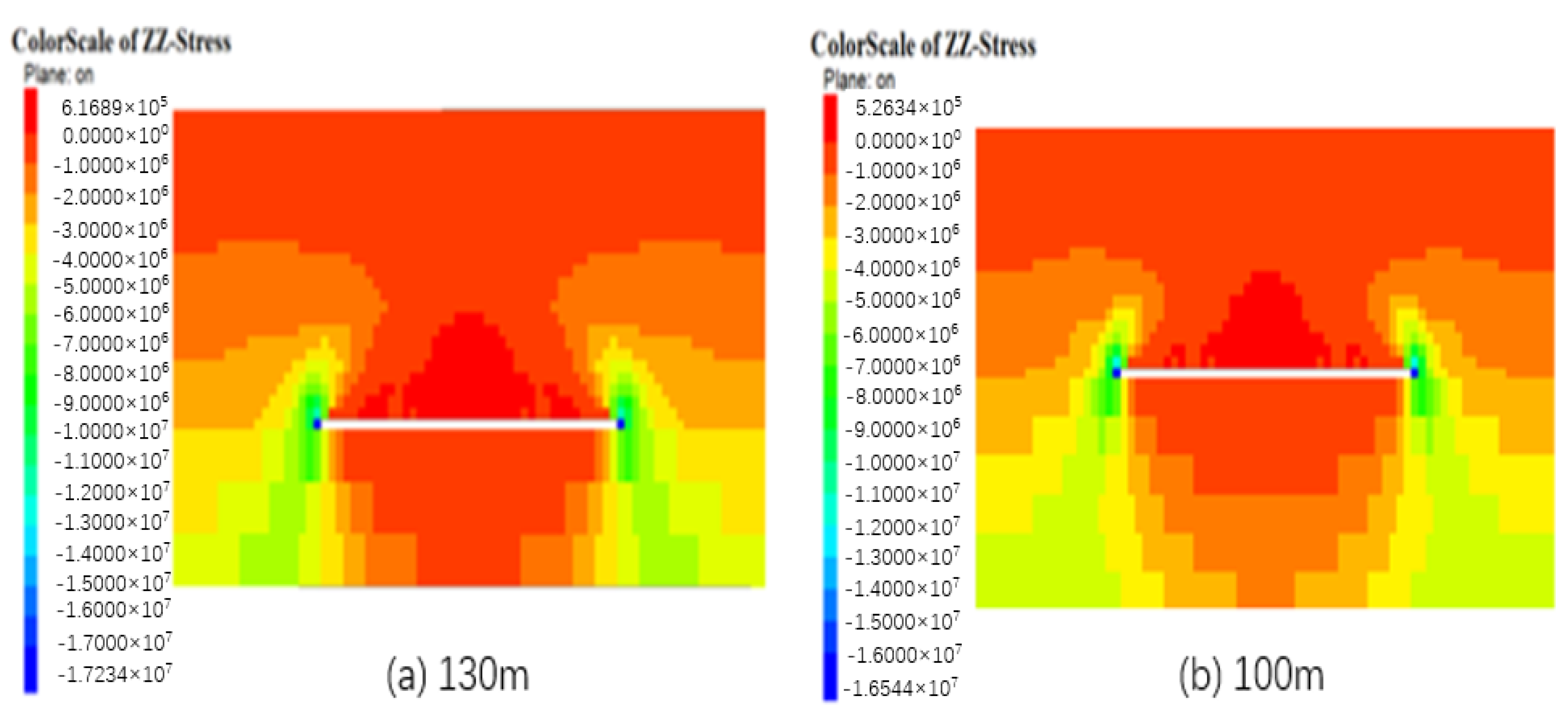
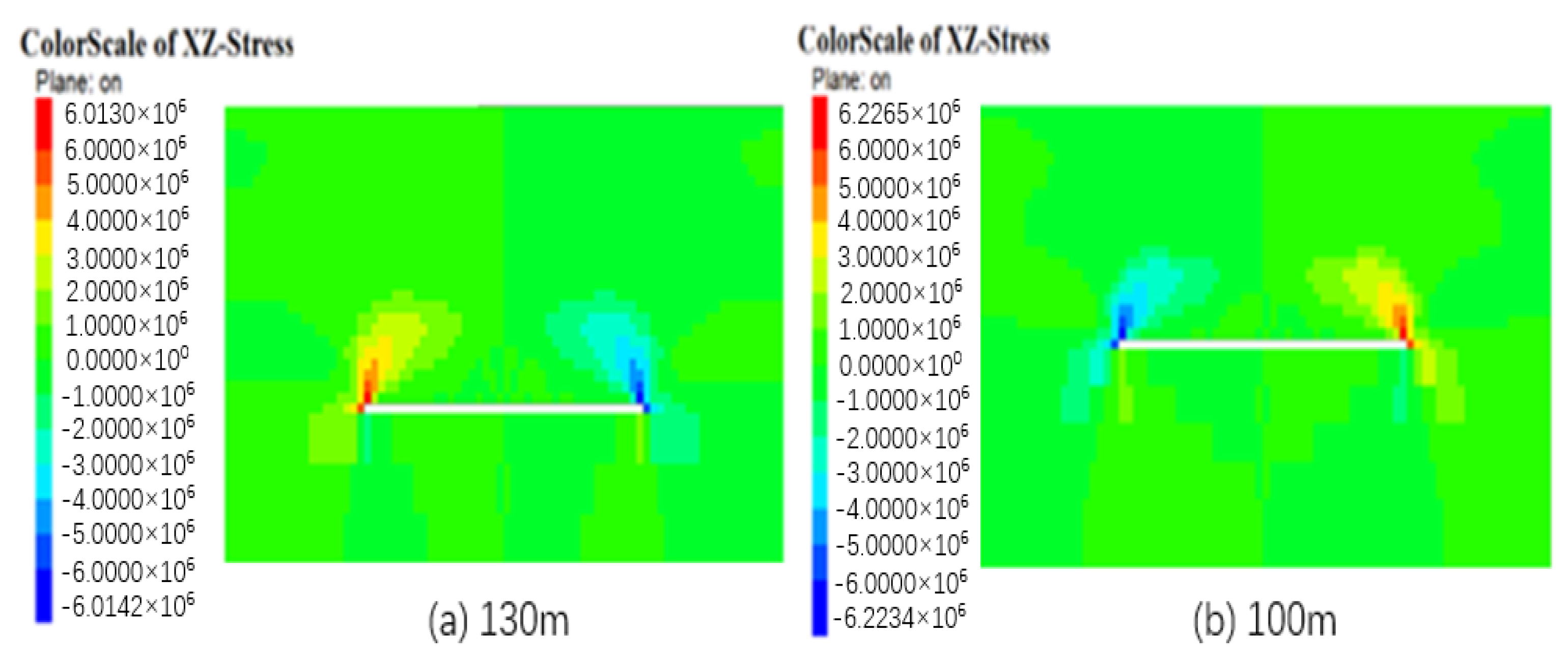
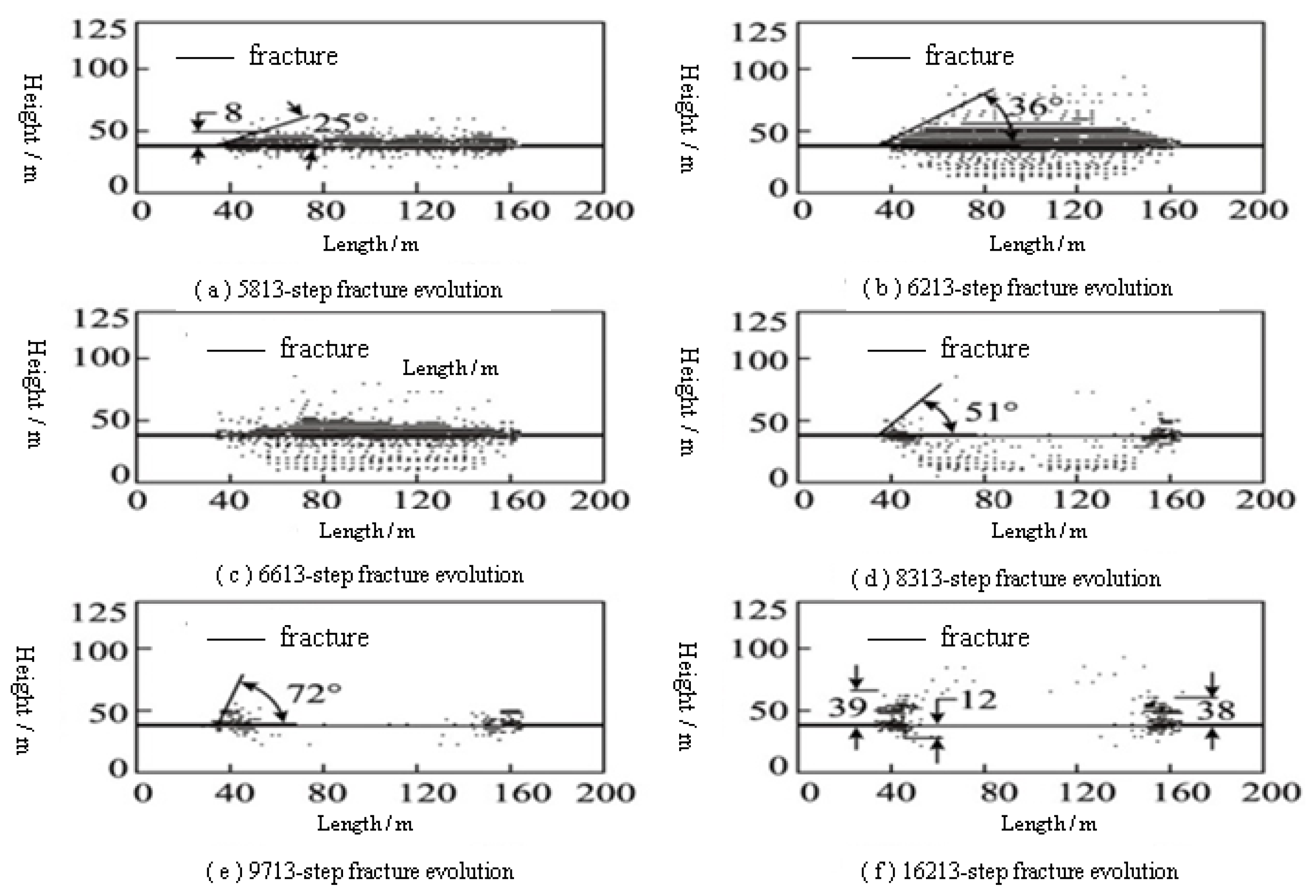
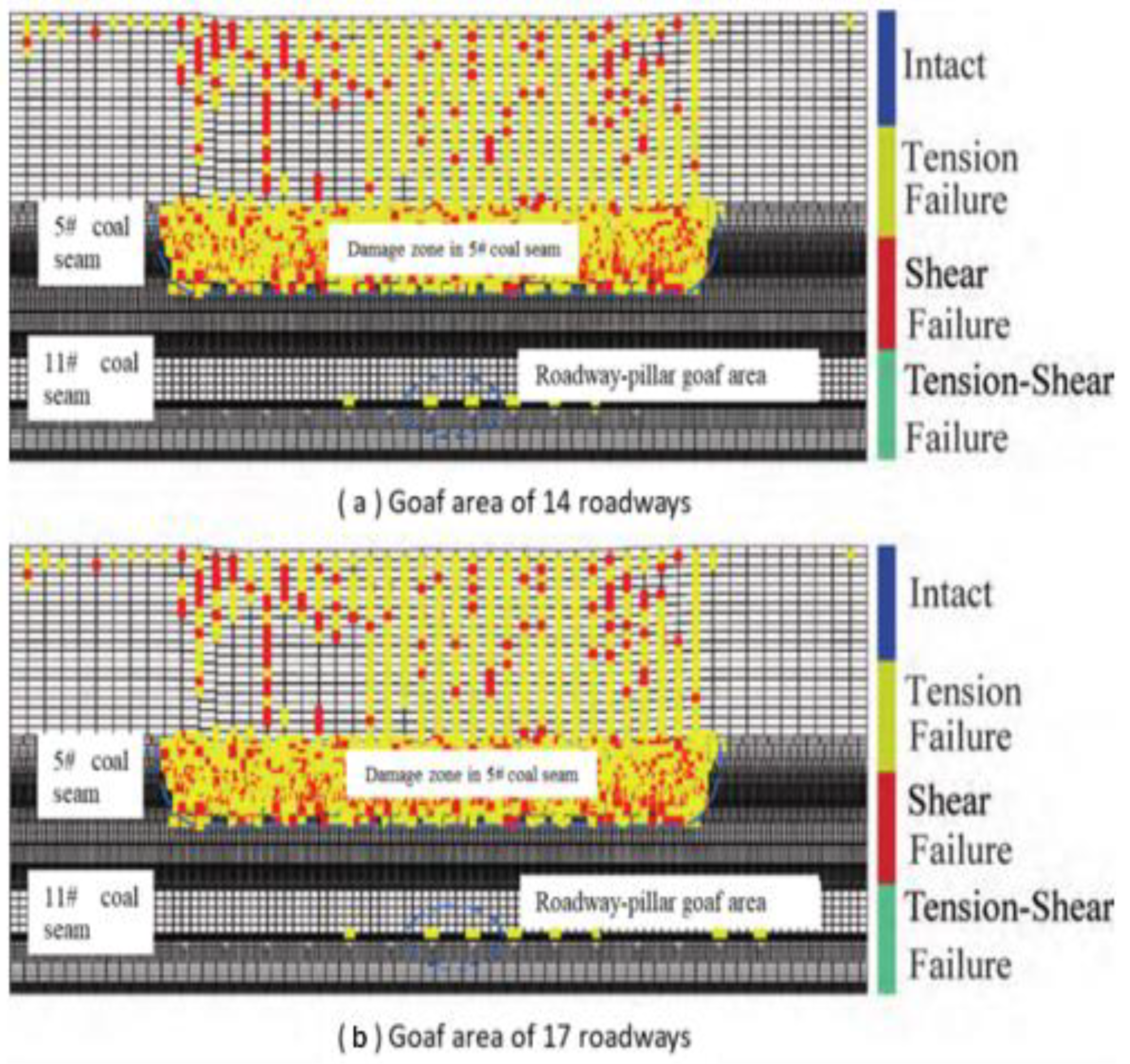
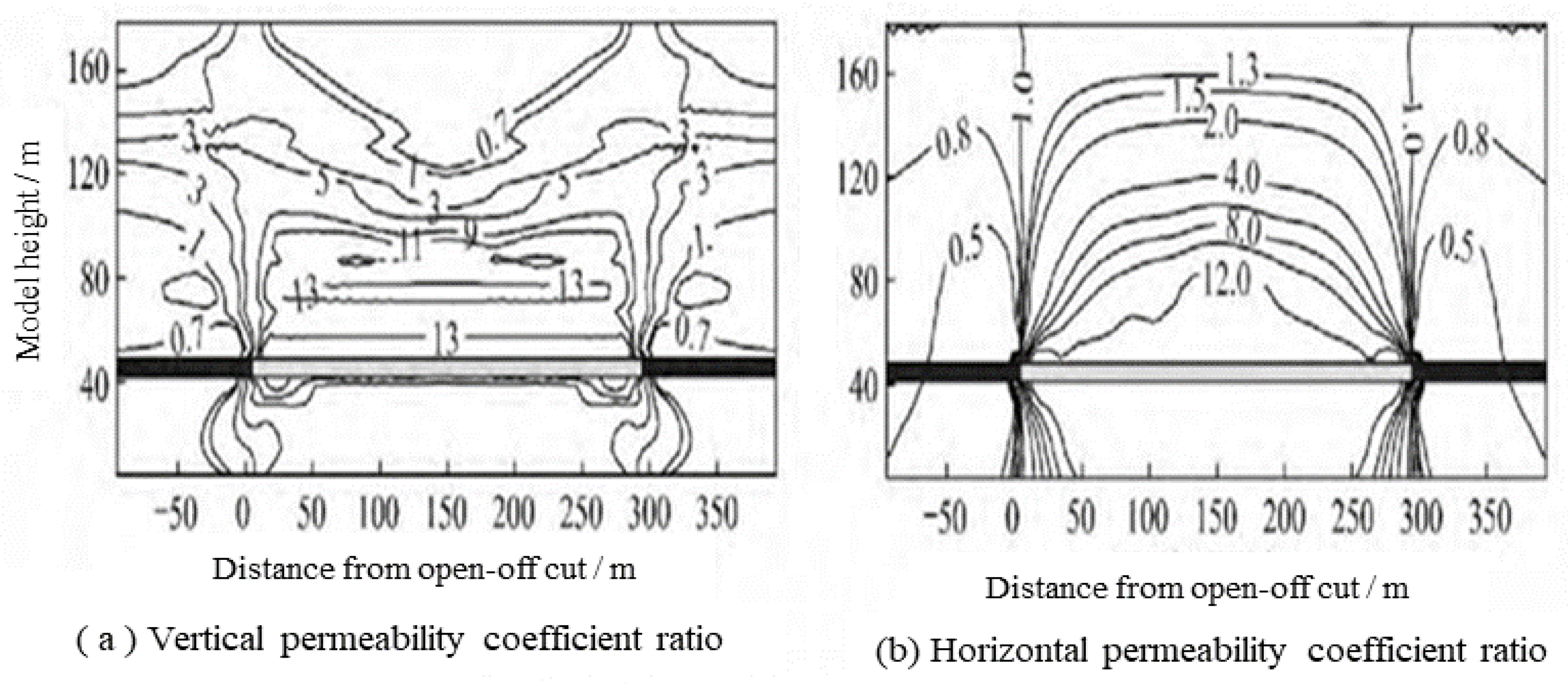
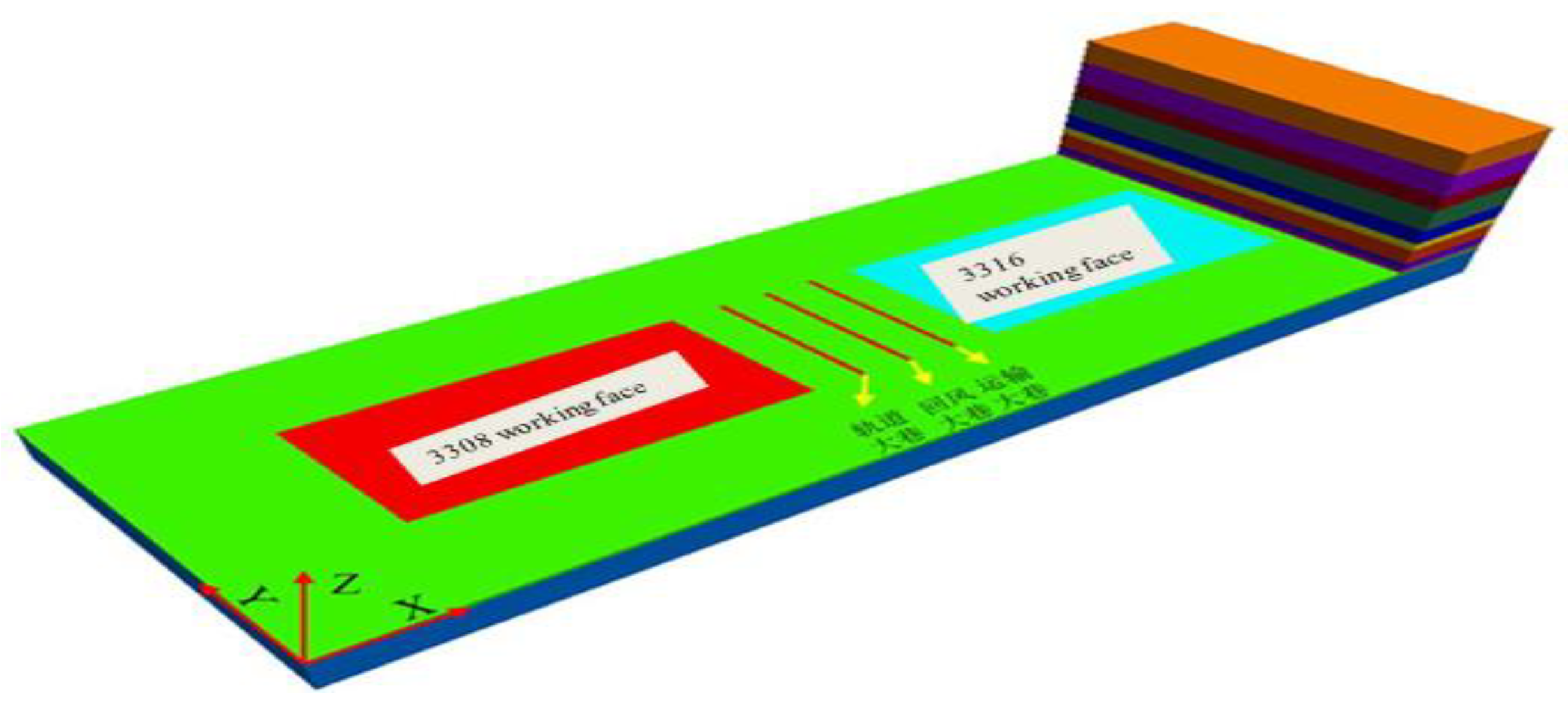
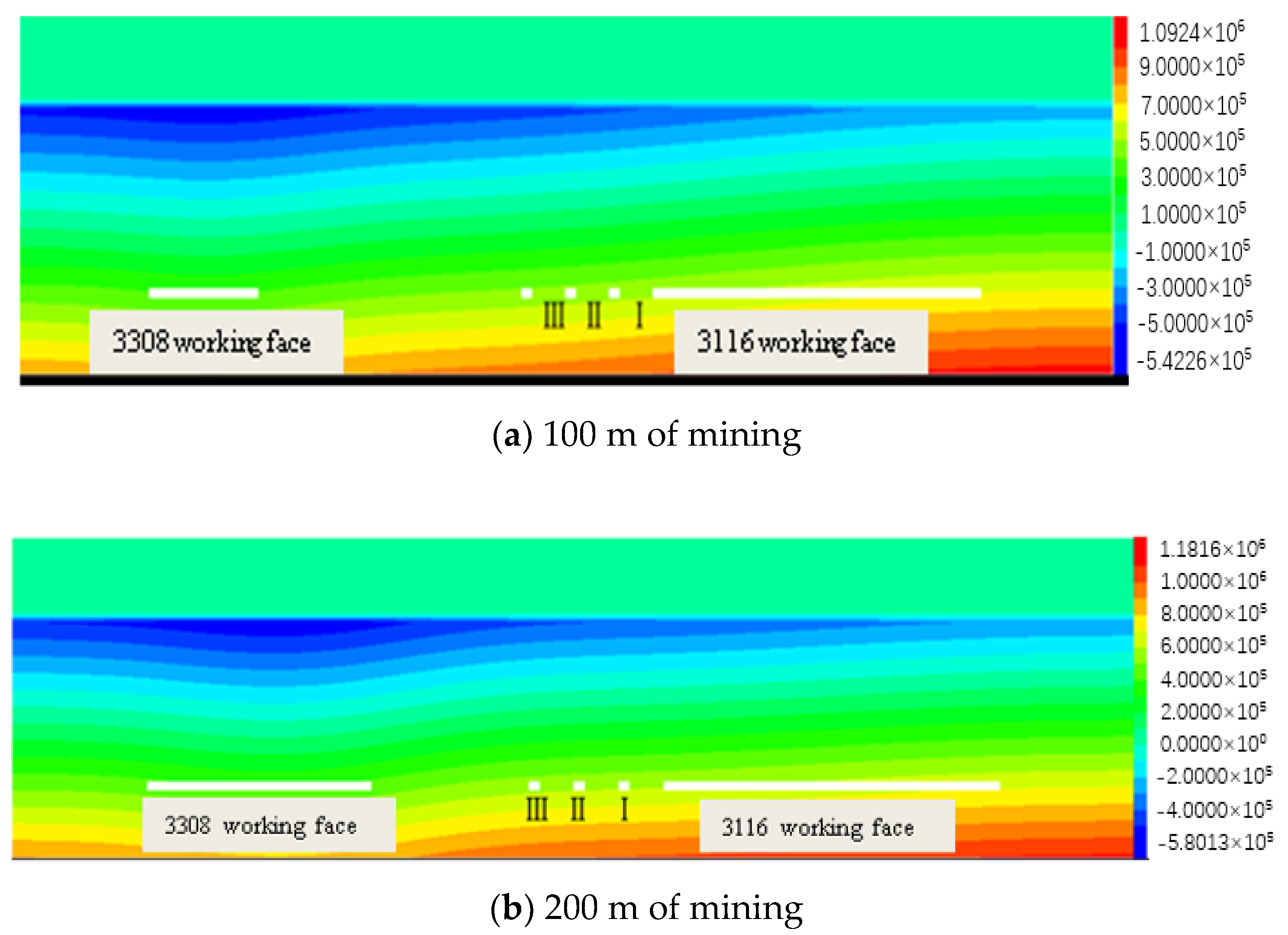
| Research Areas | Authors | Research Descriptions |
|---|---|---|
| Stress distribution characteristics of mining area | Yang et al. [12] | A physical simulation experiment of multilayer coal mining was conducted. The stress in the roadway roof experienced the relief–increase–relief process during the mining of the coal seam. |
| Whittaker and Singh [15] | There is a yield zone at the longwall-mining face and lateral coal wall. The abutment pressure is zero, and it increases rapidly with the increasing distance from the coal wall. | |
| Rezaei [18] | The longwall-mining face and its surrounding rock are regarded as an independent system. On this basis, an analytical model of the coal pillar and roadway-mining-stress distribution was established. | |
| Ji et al. [10] | The abutment-stress growth coefficient in front of a mining working face experiences the increase–decrease–stabilization process. | |
| Zhu et al. [16] | The distribution characteristics of the abutment pressure at a longwall-mining face under an extra-thick alluvial layer was analyzed. The theoretical-calculation model of the abutment pressure was established. | |
| Kang et al. [13] | Physical similarity experiments and numerical simulations were adopted to investigate the relationship between large-roof collapse and the abutment pressure in longwall-mining faces. An increase in the horizontal pressure of the roof to 5 times the original stress is a precursor to large-roof collapse. | |
| Di et al. [14] | By adopting COMSOL numerical simulation software, it was found that the stress-concentration zone in the overlying strata of a working face was rounded rectangular. | |
| Xie et al. [20] | The distribution of the abutment pressure is related to the thickness of the initial coal seam. Its peak value is negatively correlated to the thickness of the initial coal mining, and it is proportional to the distance from the coal wall. | |
| Qian et al. [42], Yu et al. [43] | A coal pillar could be divided into the ultimate equilibrium zone and elastic zone under the abutment pressure. As the distance to the coal-pillar boundary increases, the abutment pressure increases in the limit-equilibrium zone and decreases in the elastic zone. | |
| Wang et al. [44] | The fracture angle has an important influence on the stress distribution in the mining area. With larger fracture angles, the bearing capacity of the goaf area is larger. On the contrary, smaller fracture angles lead to a smaller bearing capacity, a reduced stress-recovery area in the coal seam, and the vertical stress increases. | |
| Yasitli and Unver [17] | A simulation study on an M3 longwall-comprehensive-mining face in Turkey was conducted. The abutment pressure reached a peak value of 14.4 MPa at 7 m in front of the working face. | |
| Yu [21] | By using the software COMSOL Multiphysics, and based on the theory of ultimate equilibrium and the conservation of the overlying load, a calculation method of the range and stress of the coal-wall-support influence zone and stress-recovery zone is proposed. | |
| Gao [24] | The stress distribution within the overlying strata of the goaf area under different mining depths was explored by FLAC3D numerical simulation. It was concluded that there are compressive- and tensile-stress zones within the overlying strata. | |
| Wang et al. [23] | Based on the decay law of the average bulking coefficient of fractured rock, a model of underground-coal-mining goaf evolution was established. | |
| Development pattern of fractures in mining area | Zhang et al. [26] | The fractures in the overlying strata of a shallowly buried coal seam were studied. The effects of the shallow burial depth on the evolution of the fracture development and gas-seepage pattern were analyzed. |
| Zhao et al. [27] | The evolution pattern of the overlying fractures under the large-mining-height conditions of composite roofs was tested by field measurement. | |
| Li et al. [25] | A similar-material simulation test and theoretical analysis were adopted to reveal the influencing mechanism of multiple mining on the development of fractures in overlying strata. | |
| Qian et al. [30] | Model experiments, image analysis, and discrete element simulation were conducted to reveal the two-stage development pattern and “O” circle distribution characteristics of the overlying mining fissures of a longwall mining face. | |
| Zhao et al. [28] | Taking the 8201 mining face of the Caochanggou mine as the target, the rock integrity and bearing capacity of the floor strata affected by repetitive mining between the close coal seams were investigated through numerical simulation and borehole probing. | |
| Liu et al. [31] | Affected by roof excavation, there is a significant increase in gas-conducting fractures. However, the rupture of collapsed roofs provides good support to the overlying strata, making it more difficult to break the roof above the overlying strata, and thus reducing the gas-conducting fractures there. | |
| Permeability distribution characteristics in mining stope | Zhang et al. [33] | According to the deformation and force characteristics in roof strata, and the fracture-development patterns and channel-conduction characteristics during mining, the macroscopic gas channels in the roof were classified into the gas-turbulence channel, transition channel, and seepage channel. |
| Xiong et al. [34] | The single-fracture-flow characteristics were studied from three aspects: the fluid-motion pattern, fracture-flow influencing factors, and numerical simulation methods of single-fracture seepage. It was revealed that the fracture-seepage-flow pattern is complex. | |
| Zhang et al. [45] | With the premise of fixed-fracture laminar flow, physical-model tests have an irreplaceable role in studying the fractured-rock-seepage characteristics, and more tests are needed to simulate the actual mining of rock fractures. | |
| Meng et al. [35] | A FLAC3D simulation analysis showed that the permeability distribution of the goaf zone is consistent with its stress, strain, and damage characteristics. | |
| Wang et al. [36] | Based on the cubic law, the fracture–stress–seepage equation is derived. The coal pore-water-pressure and seepage-velocity parameters were analyzed by FLAC 3D numerical simulation, as well as the permeability variation in the overlying strata at the boundary of a mining stope. |
Publisher’s Note: MDPI stays neutral with regard to jurisdictional claims in published maps and institutional affiliations. |
© 2022 by the authors. Licensee MDPI, Basel, Switzerland. This article is an open access article distributed under the terms and conditions of the Creative Commons Attribution (CC BY) license (https://creativecommons.org/licenses/by/4.0/).
Share and Cite
Gong, X.; Xue, S.; Han, B.; Zheng, C.; Zhu, L.; Dong, Y.; Li, Y. Research Progress on Stress–Fracture–Seepage Characteristics for Hazard Prevention in Mine Goafs: A Review. Sustainability 2022, 14, 12107. https://doi.org/10.3390/su141912107
Gong X, Xue S, Han B, Zheng C, Zhu L, Dong Y, Li Y. Research Progress on Stress–Fracture–Seepage Characteristics for Hazard Prevention in Mine Goafs: A Review. Sustainability. 2022; 14(19):12107. https://doi.org/10.3390/su141912107
Chicago/Turabian StyleGong, Xuanping, Sheng Xue, Baiqing Han, Chunshan Zheng, Licheng Zhu, Yangyang Dong, and Yaobin Li. 2022. "Research Progress on Stress–Fracture–Seepage Characteristics for Hazard Prevention in Mine Goafs: A Review" Sustainability 14, no. 19: 12107. https://doi.org/10.3390/su141912107
APA StyleGong, X., Xue, S., Han, B., Zheng, C., Zhu, L., Dong, Y., & Li, Y. (2022). Research Progress on Stress–Fracture–Seepage Characteristics for Hazard Prevention in Mine Goafs: A Review. Sustainability, 14(19), 12107. https://doi.org/10.3390/su141912107







